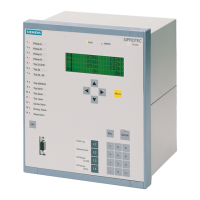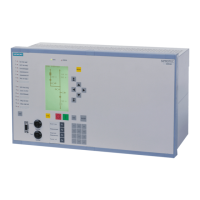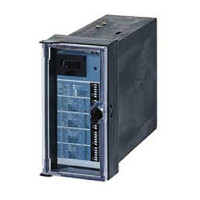•
Address 2314 or 2315 for pickup value 3I0>,
•
Address 2316 for delay time T 3I0>;
for inverse time overcurrent protection 3Ι0 acc. to IEC characteristics:
•
Address 2321 or 2322 for pickup value 3I0p,
•
Address 2323 for time multiplier T 3I0p;
for inverse time overcurrent protection 3Ι0 acc. to ANSI characteristics:
•
Address 2321 or 2322 for pickup value 3I0p,
•
Address 2324 for time multiplierr D 3I0p.
User-Defined Curves
For inverse time overcurrent protection the user may define his own tripping and dropout characteristic. For
configuration in DIGSI a dialogue box appears. Enter up to 20 pairs of current and tripping time values.
The procedure is the same as for “Phase Current Stages” under “User-specific Characteristics” (see Section
2.4.2.1 Setting Notes).
To create a user defined tripping characteristic, the following must have been set for configuration of the
scope of functions: address 122 DMT/IDMT 3I0 the option User Defined PU. Should you also wish to
specify the dropout characteristic, select option User def. Reset.
Inrush Restraint
At address 2202 InRushRest. 3I0 of the general settings, the inrush restraint can be enabled (ON) or disa-
bled (OFF). Especially for transformers and if overcurrent time protection is activated on the earthed supply
side, this inrush restraint is required. Function parameters of the inrush restraint are set in “Inrush”.
The inrush restraint is based on the evaluation of the 2nd harmonic present in the inrush current. The ratio of
2nd harmonics to the fundamental component 2.HARM. 3I0 (address 2241) is set to Ι
2fN
/Ι
fN
= 15 % as
default setting. It can be used without being changed. To provide more restraint in exceptional cases, where
energising conditions are particularly unfavourable, a smaller value can be set in the above-mentioned
address.
If the current exceeds the value indicated in address 2242 or 2243 I Max InRr. 3I0, no restraint will be
provoked by the 2nd harmonic.
Additional Time Overcurrent Protection Functions for Residual Current
In the aforementioned description, the first overcurrent protection for zero sequence current is described. The
differences in the parameter addresses and message numbers of the first, second and third overcurrent
protection are illustrated in the following table. The positions marked by x are identical.
Addresses of the
parameters
Addresses of the
dynamic parame-
ters
Message no.
1st time overcurrent protection for residual
current
22xx 23xx 191.xxxx(.01)
2nd time overcurrent protection for residual
current
34xx 35xx 321.xxxx(.01)
3 rd time overcurrent protection for residual
current
36xx 37xx 323.xxxx(.01)
NOTE
If the time overcurrent protection is assigned to a side of the main protected object, the current values are
set referred to the rated current of that side Ι/Ι
NS
.
Functions
2.4 Time Overcurrent Protection for Phase and Residual Currents
158 SIPROTEC 4, 7UT6x, Manual
C53000-G1176-C230-5, Edition 09.2016

